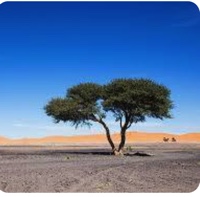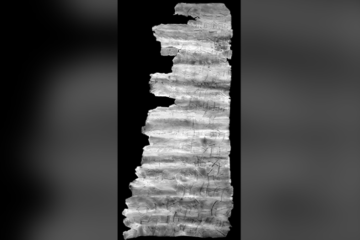In 2014, a French-led team of scientists using radar from satellite imagery located a vast, ancient river system beneath the West Saharan desert. At least one of the river systems was estimated to have been 100 km wide. These rivers once carried water for hundreds of miles all the way to the sea. This discovery confirmed the archeological theory that 130,000 years ago, the Saharan desert was a primeval jungle and a plush, verdant thriving forest.
Today, there are still sparse remnants of this forest. There are great Saharan trees that exist surrounded by miles of sand. How is this possible, especially given the fact there is never rarely any rain in the Sahara?
C.S. Lewis, in his famous book Chronicles of Narnia, refers to these Saharan trees as “the deep magic”. He calls them signatures, remnants of a once rich, thriving eco-system. Somehow, these trees have survived the intense pressures, sandstorms and the demands of the external desert until their roots sank deep below to ancient rivers bathing them in rich minerals and nutrients.
To borrow from C.S. Lewis’ metaphor, the post-Christian culture we live in today has become like a vast Saharan desert. Travel outside the bible belt, visit our renowned universities, listen carefully to modern lyrics from celebrities like Taylor Swift, and you will see this sad, unmistakable reality unfolding.
My wife, Flo is from France. One of our favorite things to do is to travel to France, rent a car, get out of the city, and just meander to small towns throughout rural, southern France. And in virtually every town you come to, there is a beautiful, majestic cathedral built back in the 1100s. We make a point to go inside these churches in every town we visit, and we marvel at the Gothic architecture, the spires reaching toward heaven, the colorful stained-glass windows and enormous pipe organs.
I have noticed that in each village that we visit these cathedrals are situated in the very center of town. Why is this? The reason is for centuries, in these towns, the church was the center of human activity.
Today, many of these churches are museums; empty shells that are but faint shadows of their once glory. Places where tourists go to catch a glimpse of the past, and to admire the trappings of Christianity, but see only rows of empty pews and the traces of what once was centuries ago a vibrant place of worship. Like a vast Saharan desert, churches like these are scattered all across Europe.
C.S. Lewis said Christians are the Saharan trees in our culture. They should be like an oasis to a thirsty world of skeptics who have never sipped the living water of God. Dietrich Bonhoffer said: “Your life as a Christian should make non-believers question their disbelief in God.”
Lee Strobel, the Atheist-turned-Christian writer and journalist said it best. “You cannot build your life with a consistent world view that is based on the shifting sands of moral relativism”.
Shifting sands of moral relativism – the Saharan desert.
As a lawyer defending religious liberty claims, I often am privileged to represent individuals who are living testaments to the power of faith. I’ve witnessed miracles take place in court rooms as prosecutors stutter and stumble when cross-examining my client. I am often asked to pray with them before a trial and I see the tears they shed, not that they would be vindicated, but that God would be glorified.
Saharan trees who are not sustained by the mere chance of a surface rain, but whose roots sink deep to rivers of living water.
(Borrowed from a presentation to the Tennessee Christian Chamber of Commerce, September 24, 2024.)
Larry Crain, www.crainlaw.legal














